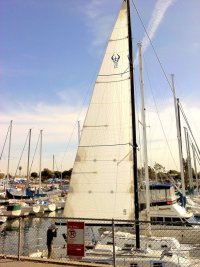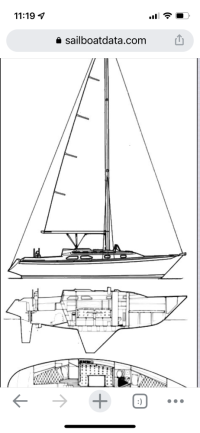Prairie Schooner
Jeff & Donna, E35-3 purchased 7/21


Replacing our baggy old mainsail and furled jib (currently ~110%) is next on the list of upgrades for our dear old Ericson. This is our first time purchasing sails. We went to the Newport (RI) Boat Show this past Thursday and spoke, at least briefly, with five sailmakers. Two of them we asked for quotes. Both are long-established companies, now aligned with one of the big franchises, and we were talking with principals. New England has a wide variety of cruisers and racers so they’ve seen it all.
Our pitch to them is that we will be cruising, but both of us have racing backgrounds. We’re likely to sail the boat a bit harder than some cruisers, go out in weather others might not. We’ll do day sailing, hopefully 3-5 three-day trips and 1-2 weeks-long trips per year. We plan to do some day-long club races, but no weekly round-the-buckets. Which isn’t to say we’re anything like GP rockstars. And we’re, well, um, older. I know you don’t have to kill your sails to have a lovely day on the water, and with all the stress, you might not arrive much more than a half hour earlier. But, I’ve come to realize that optimizing the boat and trimming sails is one of the ways I enjoy sailing. We can’t afford top-of-the-line, but don’t want to be disappointed. Rather than ultimate performance out of the box, our preference is good performance that lasts more years. It could be that I'm just an old guy who is imagining himself in a Ferrari and all I'm going to do is go down the street for groceries. Kind of like putting racing tires on a Camry.
The quotes are back already and the differences in recommendations is interesting.
Crosscut v Tri-Radial
One loft firmly recommended tri-radial construction with appropriate cloth, saying the sails would hold their shape better when pressed and much longer into their life. The other said the difference wasn’t great enough to warrant the extra expense.
Polyester v Laminate
One loft said laminate wouldn’t offer enough performance bonus to justify the price, and steered us toward an upper range Dacron. This is the same loft that recommended crosscut. The other recommended Contender CDX Pro laminate, saying it would last as long as Dacron but hold shape longer into its life.
Full Battens v 2+2
Two full battens (upper) and two partial (lowers) was recommended because the extra flexibility lower down would give greater ability to shape the sail. The advocate for full battens said this was true, but as the sail ages there will be uneven stretch in the lower front quarter of the sail which will create bad sail shape. Full battens would mean a sacrifice in flexibility early to buy better shape later. (I asked if he could add full battens at year 5. He said it would be a botch retrofit that wouldn’t work well.)
Furling Luff material for Jib Reefing
One loft said he uses rope because the foam compresses over time and doesn’t work as well as the sail ages. The other prefers the more even distribution of shape from 'crescented' foam and hasn’t had a problem with deterioration/compression.
Both lofts made the following recommendations:
For local conditions and our sailing preferences, go with a 135% jib. (I’ve read some of the discussions here regarding jib size. We also have an original 'storm jib' and a 150, both more lightly used, as well as a more recent second-hand asymmetrical spinnaker.)
Rather than three mainsail reefs, use two and place them a little higher.
Switch to a loose footed main.
To save a few shekels, would it make sense to go with one sail more performance oriented (jib or main) and the other more sturdy cruiser? If so, which?
Any and all opinions and experiences are welcome. I don’t even know what a rope 'bulked' luff looks like, so If you have pictures we’d like to see them.
I found these threads here:
32-3 new sails https://ericsonyachts.org/ie/threads/32-3-sails-and-compare-the-5-annapolis-sail-lofts.16962/page-2
34-2 headsail size https://ericsonyachts.org/ie/threads/headsail-size-selection-e34-2.19524/#post-152362
FX v Ullman https://ericsonyachts.org/ie/threads/fx-vs-ullman-sails.18947/
jib shredded https://ericsonyachts.org/ie/threads/it-was-an-expensive-weekend-jib-shredded.17859/
If there are other conversations here that I missed, I appreciate a link.
Thanks much!
Jeff & Donna






